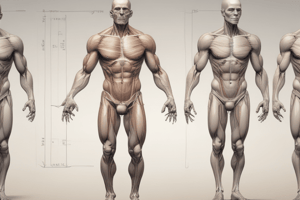Podcast
Questions and Answers
What is the muscle that forms the medial border of the femoral triangle?
What is the muscle that forms the medial border of the femoral triangle?
- Fibularis longus
- Extensor carpi radialis brevis
- Brachioradialis
- Iliopsoas (correct)
What is the action of the adductor component of the adductor magnus muscle?
What is the action of the adductor component of the adductor magnus muscle?
- Extend the thigh
- Abduct the thigh
- Flex the thigh (correct)
- Rotate the thigh
What anatomical landmark can be used to locate the common fibular nerve?
What anatomical landmark can be used to locate the common fibular nerve?
- Fibularis longus (correct)
- Lesser trochanter of the femur
- Neck of the fibula
- Head of the fibula
Which nerve innervates the adductor part of the adductor magnus muscle?
Which nerve innervates the adductor part of the adductor magnus muscle?
What is the innervation of the iliacus muscle?
What is the innervation of the iliacus muscle?
What is the action of the brachioradialis muscle at the elbow?
What is the action of the brachioradialis muscle at the elbow?
What is the origin of the psoas major muscle?
What is the origin of the psoas major muscle?
What is the action of the iliopsoas muscle at the hip joint?
What is the action of the iliopsoas muscle at the hip joint?
Which muscle lies on the aponeurosis that covers the adductor canal?
Which muscle lies on the aponeurosis that covers the adductor canal?
What type of joint is the shoulder joint?
What type of joint is the shoulder joint?
How many muscles are there in the superficial layer of the posterior forearm?
How many muscles are there in the superficial layer of the posterior forearm?
How many muscles are in the deep anterior forearm?
How many muscles are in the deep anterior forearm?
What is the action of the flexor digitorum profundus muscle?
What is the action of the flexor digitorum profundus muscle?
What is the termination point of the common fibular nerve?
What is the termination point of the common fibular nerve?
What is the name of the canal that the adductor canal is also known as?
What is the name of the canal that the adductor canal is also known as?
What is the boundary of the adductor canal anteriorly?
What is the boundary of the adductor canal anteriorly?
Flashcards are hidden until you start studying
Study Notes
Adductor Magnus
- Adductor magnus has two components: adductor and hamstring parts
- The adductor part adducts and flexes the thigh, while the hamstring part extends the thigh
- Innervation: adductor part by obturator nerve (L2-L4), hamstring part by tibial nerve (L4-S3)
Shoulder Joint
- The shoulder joint (glenohumeral joint) is a ball and socket joint between the scapula and the humerus
- It connects the upper limb to the trunk and is one of the most mobile joints in the human body
Adductor Canal (Hunter's Canal or Subsartorial Canal)
- Located on the medial side of the middle one-third of the thigh
- A narrow conical tunnel that extends from the apex of the femoral triangle to the hiatus of adductor magnus
- Serves as a passage for structures passing through the anterior thigh and posterior leg
Adductor Longus
- A large, flat muscle that partially covers the adductor brevis and magnus
- Forms the medial border of the femoral triangle
Clinical Relevance: Locating the Common Fibular Nerve
- The common fibular nerve can be located using the fibularis longus as an anatomical landmark
- Passes through a small space between the parts of the fibularis longus that originate from the head of the fibula and the neck of the fibula
- After passing through the gap, the nerve terminates by bifurcating into two terminal branches: the deep and superficial fibular nerve
Iliopsoas
- Consists of two muscles: psoas major and iliacus
- Originate in different areas but come together to form a tendon
- Attachments: psoas major from lumbar vertebrae, iliacus from iliac fossa of the pelvis; insert together onto the lesser trochanter of the femur
- Actions: flexes the lower limb at the hip joint and assists in lateral rotation at the hip joint
- Innervation: psoas major by anterior rami of L1-3, iliacus by the femoral nerve
Superficial Muscles of the Posterior Forearm
- Contains seven muscles, including four that share a common tendinous origin at the lateral epicondyle
Brachioradialis
- A paradoxical muscle with characteristics of both extensor and flexor muscles
- Origin and innervation are characteristic of an extensor muscle, but it is actually a flexor at the elbow
Studying That Suits You
Use AI to generate personalized quizzes and flashcards to suit your learning preferences.




